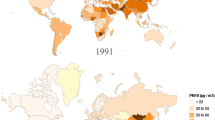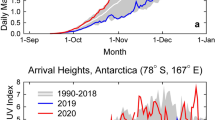Abstract
In this contribution, iodine chemistry in the Marine Boundary Layer (MBL) is introduced. A series of methodologies for the measurements of iodine species in the gas and particle phases of the coastal atmosphere has been developed. Iodine species in the gas phase in real air samples has been determined in two field campaigns at the west coast of Ireland, indicating that gaseous iodo-hydrocarbons and elemental iodine are the precursors of new particle formation. Particulate iodine speciation from the same measurement campaigns show that the non-water-soluble iodine compounds are the main iodine species during the marine particle formation. A seaweed-chamber experiment was performed, indicating that gaseous I2 is one of the important precursors that lead to new particle formation in the presence of solar light in the ambient air at the coastal tidal area.
Similar content being viewed by others
References
O’Dowd C. D., Hämeri K., Mäkelä J., Väkeva M. and Aalto P., Coastal new particle formation: environmental conditions and aerosol physicochemical characteristics during nucleation bursts, J. Geophys. Res. 2002, 107: 8107
O’Dowd C. D. et al., Atmospheric science: marine aerosols and iodine emissions (Reply), Nature, 2005, 433: E13–E14
Kolb C. E., Iodine’s air of importance, Nature, 2002, 417: 597–598
Slingo A., Sensitivity of the Earth’s radiation budget to changes in the low clouds, Nature, 1990, 343: 49–51
Tsunogai S., Iodine in the deep water of the ocean, Deep-Sea Res., 1971, 18: 913–919
Ullman W. J., G.W.L., G.J. d. L. and J.R. W. W., Iodine chemistry in deep anoxic basins and overlying waters of the Mediterranean Sea, Mar. Chem., 1990, 31: 153–170
Waite T. J. and Truesdale V. W., Iodate reduction by Ioschrysis galbana is relatively insensitive to de-activation of nitrate reductase activity—are phytoplankton really responsible for iodate reduction in seawater?, Mar. Chem., 2003, 81: 137–148
Schwehr K. A. and Santschi P. H., A Sensitive Determination of Iodide Species in Fresh or Saline Matrixes Using High Performance Chromatography and UV/Visible Detection. http://loer.tamug.tamu.edu Poster, 2002
Miyake Y. and Tsunogai S., Evaporation of iodine from the ocean, J. Geophys. Res., 1963, 68: 3989–3993
Garland J. A. and Curtis H., Emission of iodine from the sea surface in the presence of ozone, J. Geophys. Res., 1981, 86: 3183–3196
Thompson A. M. and Zafiriou O. C., Air-sea fluxes of transient atmospheric species, J. Geophys. Res., 1983, 88: 6696–6708
Lovelock J. E., Natural halocarbons in the air and in the sea, Nature, 1975, 256: 193–194
Vogt R., Sander R., Glasow R. v. and Crutzen P. J., Iodine chemistry and its role in halogen activation and ozone loss in the marine boundary layer: a model study, J. Atmos. Chem., 1999, 32: 375–395
Singh H. B., Salas L. J. and Stiles R. E., Methyl halides in and over the eastern Pacific (40 N-32 S), J. Geophys. Res., 1983, 88: 3684–3690
Carpenter L. J. and Lewis A. C., Ocean-atmosphere exchange of reactive halocarbons and hydrocarbons, Recent Res. Dev. Geophys., 2002, 4: 45–56
Vogt R., Iodine compounds in the atmosphere. In: The Handbook of Environmental Chemistry, Vol. 4 Part E, Berlin Heidelberg: Springer-Verlag, 1999, 144–128
Saiz-Lopez A. and Plane J. M. C., Novel iodine chemistry in the marine boundary layer, Geophys. Res. Lett., 2004, 31: L04112
Gaebler H. E. and Heumann K. G., Determination of atmospheric iodine species using a system of specificly prepared filters and IDMS, Fresenius’ J. Anal. Chem., 1993, 345: 53–59
Alicke B., Hebestreit K., Stutz J. and Platt U., Iodine oxide in the marine boundary layer, Nature 1999, 397: 572–573
Allan B. J., Planc J. M. and Mcfiggans G., Observations of OIO in the remote marine boundary layer, Geophys. Res. Lett., 2001, 28: 1945–1948
Hoffmann T., O’Dowd C. D. and Seinfeld J. H., Iodine oxide homogeneous nucleation: an explanation for coastal new particle production, Geophys. Res. Lett., 2001, 28: 1949–1952
O’Dowd C. D. et al., On the photochemical production of new particles in the coastal boundary layer, Geophys. Res. Lett., 1999, 26: 1707–1710
O’Dowd C. D. et al., Marine aerosol formation from biogenic iodine emissions, Nature, 2002, 417: 632–634
Adams J. W. and Cox R. A., Halogen chemistry of the marine boundary layer, J. Phys., IV, 2002, 12: 105–124
Carpenter L. J., Iodine in the marine boundary layer, Chem. Rev., 2003, 103: 4953–4962
Saiz-Lopez A., Saunders R. W., Joseph D. M., Ashworth S. H. and Plane J. M. C., Absolute absorption cross-section and photolysis rate of I2 Atmos. Chem. Phys., 2004, 4: 1443–1450
Cotter E. S. N., Booth N. J., Canosa-Mas C. E. and Wayne R. P., Release of iodine in the atmospheric oxidation of alkyl iodides and the fates of iodinated alkoxy radicals. Atmos. Environ., 2001, 35: 2169–2178
Carpenter L. J. et al., Short-lived alkyl iodides and bromides at Mace Head, Ireland: links to biogenic sources and halogen oxide production, J. Geophys. Res. (Atmospheres), 1999, 104: 1679–1689
Jenkin M. E., The photochemistry of iodine-containing compounds in the marine boundary layer, Environ. and Energy Rep. AEA EE-0405, Oxfordshire, England: AEA Harwell Lab., 1992
Stutz J., Hebestreit K., Alicke B. and Platt U., Comparison of model calculations with recent field data, J. Atmos. Chem., 1999, 34: 65–85
Davis D. et al., Potential impact of iodine on tropospheric levels of ozone and other critical oxidants, J. Geophys. Res. (Atmospheres), 1996, 101: 2135–2147
Cox R. A., Bloss W. J., Jones R. L. and Rowley D. M., OIO and 1857–1860
Rowley D. M., Bloss W. J., Cox R. A. and Jones R. L., Kinetics and products of the IO + BrO reaction, J. Phys. Chem. A, 2001, 105: 7855–7864
Bloss W. J., Rowley D. M., Cox R. A. and Jones R. L., Kinetics and products of the IO self-reaction, J. Phys. Chem. A, 2001, 105: 7840–7854
Misra A. and Marshall P., Computational investigations of iodine oxides, J. Phys. Chem. A, 1998, 102: 9056–6060
Baker A. R., Thompson D., Campos M. L. A. M., Parry S. J. and Jickells T. D., Iodine concentration and availability in atmospheric aerosol, Atmos. Environ., 2000, 34: 4331–4336
Holmes N. S., Adams J. W. and Crowley J. N., Uptake and reaction of HOI and on frozen and dry IONO2 NaCl/NaBr surfaces and H2SO4, Phys. Chem. Chem. Phys., 2001, 3: 1679–1687
Mäkelä J. M. et al., Biogenic iodine emissions and identification of end-products in coastal ultrafine particles during nucleation bursts. J. Geophys. Res., 2002, 107: 8110
Ashworth S. H., Allan B. J. and Plane J. M. C., High resolution spectroscopy of the OIO radical: implications for the ozone-depleting potential of iodine in the marine boundary layer, Geophys. Res. Lett., 2002, 29: 1456
McFiggans G., Cox R. A., Mossinger J. C., Allan B. J. and Plane J. M. C., Active chlorine release from marine aerosols: roles for reactive iodine and nitrogen species, J. Geophys. Res. (Atmospheres), 2002, 107
McFiggans G. et al., A modeling study of iodine chemistry in the marine boundary layer, J. Geophys. Res. (Atmospheres), 2000, 105: 14371–14385
Carpenter L. J., Hebestreit K., Platt U. and Liss P. S., Coastal zone production of IO precursors: a 2-dimensional study, Atmos. Chem. Phys. 2001, 1: 9–18
Burkholder J. B., Curtius1 J., Ravishankara A. R. and Lovejoy E. R., Laboratory studies of the homogeneous nucleation of iodine oxides, Atmos. Chem. Phys. Discuss., 2003, 3: 4943–4988
McFiggans G. et al., Direct evidence for coastal iodine particles from Laminaria macroalage — linkage to emissions of molecular iodine, Atmos. Chem. Phys. Discuss., 2004, 4: 939–967
Hofmann K. A., Lehrbuch für Anorganische Chemie, 1924
Rosenfeld L., Discovery and early uses of iodine, J. Chem. Educ., 2000, 77: 984–987
Mader B. T., Flagan R. C. and Seinfeld J. H., Sampling atmospheric carbonaceous aerosols using a particle trap impactor/denuder sampler, Environ. Sci. Technol., 2001, 35: 4857–4867
Simon P. K. and Dasgupta P. K., Continuous automated measurment of gaseous nitrous and nitric acids and particlate nitrite and nitrate, Environ. Sci. Technol., 1995, 29: 1534–1541
Taira M. and Kanda Y., Wet effluent diffusion denuder for sampling of atmospheric gaseous nitric acid, Anal. Chem., 1993, 65: 3171–3173
Hon P. K., Mak T. C. W. and James T., Synthesis and structure of l-methyl-1,3,5,7-tetraazaadamantan-1-ium octaiodide, [(CH2)6N4CH3]2I8. A new outstretched 2 configuration for the polyiodide ion 182-. Inorg. Chem., 1979, 18: 2916–2918
Knapp G., Maichin B., Fecher P., Hasse S. and Schramel P., Iodine determination in biological materials options for sample preparation and final determination, Fresenius’ J. Anal. Chem. 1998, 362: 508–513
Hou X. et al., Determination of chemical species of iodine in seawater by radiochemical neutron activation analysis combined with ion-exchange preseparation, Anal. Chem., 1999, 71: 2745–2750.
Yoon Y. J. et al., Biogenic aerosol and gas flux study in and around Mace Head. In. Kasahara M and Kulmala M (eds.), Proc. E 16th International Conf. Nucleation and Atmospheric Aerosols (ICNAA)/Kyoto, Japan, Kyoto University Press, 2004, 674–677
Baker A. R., Tunnicliffe C. and Jickells T. D., Iodine speciation and deposition fluxes from the marine atmosphere, J. Geophys. Res., 2001, 106: 28743–28749
Baker A. R., Inorganic iodine speciation in tropical Atlantic aerosol, Geophys. Res. Lett., 2004, 31: L23S02
Author information
Authors and Affiliations
Corresponding author
About this article
Cite this article
Chen, H., Brandt, R., Bandur, R. et al. Characterization of iodine species in the marine aerosol: To understand their roles in particle formation processes. Front. Chem. China 1, 119–129 (2006). https://doi.org/10.1007/s11458-006-0001-5
Issue Date:
DOI: https://doi.org/10.1007/s11458-006-0001-5




